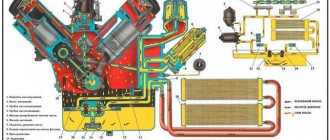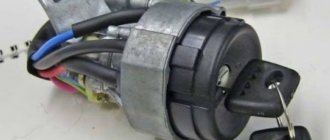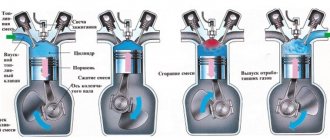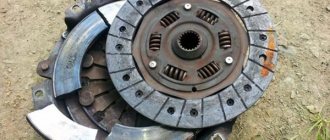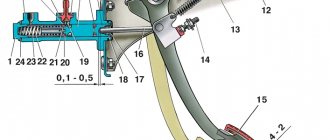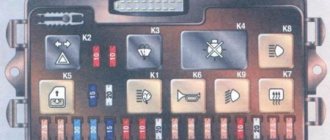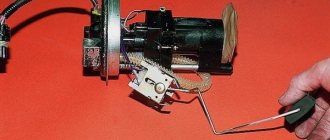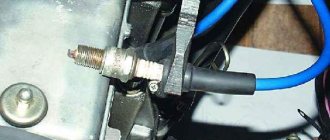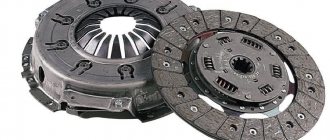Any problems in the car must be repaired immediately, otherwise a complication may follow and, as a result, complex and expensive repairs will be required (in most cases this is not an exaggeration, but a fact).
Some cars have a certain number of shortcomings that owners are prepared for when purchasing. For many motorists, oil in Priora spark plug wells has become a common occurrence, although the phenomenon does not occur so often. And therefore, owners of domestic cars are trying to solve this problem as soon as possible.
If you have the skills to restore a vehicle, you can carry out repairs yourself; no difficulties will arise during the execution.
Why does oil accumulate in the spark plug wells in Priora and what does this lead to?
The problem is common in 1.6 liter engines. In early versions, there were rubber gaskets under the valve cover, while the updated ones use exclusively sealant to tightly fit the parts.
For a modern Priora, oil in the spark plug wells is formed as a result of the sealant drying out after long-term use of the car or when using a low-quality composition. Therefore, completely removing accumulated oil and old sealant will be the right solution to the problem.
This is the same case when the plant tried to reduce costs and simplify the design. However, they did not take into account one simple rule: “Kroilovo leads to Popadalovo.” This principle can be applied to all cases in life, and in relation to your car as well.
Oil can accumulate in the Priora well even in a completely new car, therefore, immediately after purchase it is worth checking the vehicle at a service station or in your own garage. Otherwise, a brand new car can present a very unpleasant surprise, and the reason for such a dirty trick lies solely in the sealant used.
There is a high probability that after release or a long period of inactivity of the car in the cabin, the low-quality composition will simply dry out. And as a result of test or first long trips, oil will accumulate in the wells. And in order to avoid expensive repairs on the purchased model, you should not miss the opportunity, but check the quality of the installed system.
If the oil remains in the spark plug well for quite a long time, the rubber insulator of the spark plugs will soften as a result. This will lead to a very serious problem - puncture of spark plugs, insufficient supply of specialized oil to the engine.
Naturally, such a phenomenon will cause unstable operation of the power unit, as well as subsequent more frequent diagnostics and replacement of spark plugs. Therefore, for Priora, oil in spark plug wells is considered, although a common problem, but quite acute. And as a result, it requires immediate permission, otherwise untimely repairs may be necessary when the car simply stalls on a country road.
The most famous manufacturers and popular markings
Modern retail outlets that sell replacement spare parts, consumables and components for cars are replete with a huge selection of different spark plugs. As they say, for every taste and color. However, there is no need to rush. First, you need to clarify which manufacturers produce spark plugs for the Priora with a 16-valve engine. The most common brands for Priora 16 valves are made by the following manufacturers.
- Russia, JSC ZAZS, AU 17 DVRM
- Germany, Bosch, WR7DC
- Germany, Beru, 14R-7DU
- Czech Republic, Brisk, LR15YC DR15YC
- Japan NGK, BPR6ES
- Japan Denso, W20EPR.
Of course, according to established tradition, car owners try to replace Russian ones with imported parts. And especially Japanese and German ones. It must be clarified that now this desire practically does not justify itself in any way. Yes, German Bosch spark plugs, in recent tests in laboratories, showed slightly better results than Russian DVRM. However, domestic devices are confidently ahead of all other models. Including German "Beri" and Japanese "NZHK".
What to choose for replacement
In general, you should not chase well-advertised brands. It must be taken into account that the market is now filled with a huge number of fakes. And, as a rule, it is precisely those parts that are popular for replacement and that have the highest cost that are falsified. Therefore, Russian devices for Priora in this context are not of great interest to counterfeiters. Next to them, the Czech Brisk stands with confidence. They are very popular among our repairmen. Japanese "NZHK" and German "Bosch" are doing well. But here, fakes are very common. Suffice it to say that they cost about $2 per candle when purchased from the factory. And they have 7 degrees of protection. Imagine how much a set of real candles will cost here in Russia.
In general, the advice is this: don’t get too carried away with imported parts. Practice shows that Russian-made spark plugs for Priora perform excellent when replaced.
Causes of oil on spark plugs
If the candles are covered with oil, then first of all it is necessary to determine exactly which part has the most of it. Many car owners are faced with a situation where only the threads and body are coated with lubricant, while the electrodes are dry and have a normal color (light brown). But it also happens that the entire base ends up in oil.
At the same time, in addition to traces of lubricant on the spark plugs, a malfunction with the engine manifests itself in other ways - deterioration in dynamics, increased exhaust smoke, oil burns. In order for it not to be the cause, it must be eliminated.
Most often, the appearance of grease marks occurs due to wear and damage:
- Valve guides.
- Oil seals.
- Valves.
- Cylinder head gaskets (cylinder head).
- CPG elements (cylinder-piston group).
Traces of lubricant on the body and threads are mentioned for good reason, since oil can get onto the spark plug not only from the cylinder, but also due to external leaks. So, on some cars, a loose fit of the cylinder head cover gasket is considered a “disease”. As a result, candles seep through leaks and get into the wells. Thus, oil accumulates in the wells of the spark plugs and when unscrewing the spark plugs, both the body and the threads are simply smeared in the accumulated lubricant. The problem is “treated” by replacing the gasket and coating it with sealant.
Types of spark plugs: iridium and regular
The first iridium spark plugs for cars were produced by Denso. Today they claim that such parts, unlike conventional ones, have a longer service life. We installed such parts on the Priora, but did not notice the difference - perhaps this is just a marketing ploy. We don’t think that the Priora is anything special and there will be a noticeable difference on other cars. But still in terms of technology: durability is due to the gas-tight insulation of the central electrode, aluminum oxide insulators, reduced loss of electric current, a high degree of insulation, and a large volume of the ignition zone.
Denso even produces special models for AvtoVAZ. The electrodes are coated with a lubricant mixture, which increases their gas impermeability, while the temperature in the ignition unit remains optimal - premature or late ignition is excluded. The side electrode is designed in such a way that it allows ignition to be optimized; in this case, even a lean mixture will be ignited.
You can install iridium spark plugs on the Lada Priora, the advantage of which is clear - they need to be changed much less often. But the service life of these elements will be significantly lower than that declared by the manufacturer. The fault lies not in the malfunction of the car - the quality of gasoline leaves much to be desired.
As mentioned earlier, iridium spark plugs can even light a lean mixture. When they work with a contaminated mixture (and the risk of running into unscrupulous filling remains high), they suffer even more. This is comparable to the work of the lungs of a person who lives in a non-ecological area: not only does fumes settle everywhere, the wear and tear of the “organs” accelerates.
Valve replacement of ignition elements for Lada Priora 16 valves is real. Manufacturers producing analogues for this VAZ car produce similar copies from iridium. But don’t rush to rejoice: even if you are promised that the spark plugs will last about one hundred thousand kilometers, on Russian roads this is unlikely to be true.
However, take care to ensure that the cylinder head gasket is always completely sealed against leaking oil. If oil gets on your iridium spark plugs, your expensive purchase will be rendered useless.
Design
If we take into account the design of the candles, then they consist of the following elements:
- Contact output. Serves to connect high-voltage wires from the ignition system;
- Insulator. Due to it, the candles do not overheat;
- Insulator ribs. Do not allow electrical breakdowns;
- Central and side electrode. Serves to form a spark between them, which ignites the fuel mixture;
- Seal. This element prevents hot gas from escaping from the combustion chamber.
An important point in the correct operation of spark plugs is the gap between the electrodes.
Right choice
What spark plugs are best for a Priora car? For an engine with 16 valves, it is recommended to install domestic ones: A17DVMR, A15DVMR or their foreign analogues. Spark plugs for Priora must be changed according to the recommendations of the car manufacturer. As a rule, they require maintenance every 5,000 km.
What groups are they divided into? There are three types of spark plugs for the Priora car.
There is also a difference between single-electrode (standard) and multi-electrode spark plugs. The manufacturer recommends using the first option.
A set of spark plugs costs from 200 to 600 rubles - it all depends on the manufacturer and region. Prices and photos are presented in manufacturers' catalogs.
What spark plugs should you not buy for a Priora car? It is not recommended to purchase products from an unknown manufacturer. When purchasing, be sure to check the integrity of the packaging, the presence of a warranty from the seller and the date of manufacture. The service life of these parts ranges from 3 (regular) to 5 (preserved) years. The latter have a special lubricant, which must be washed off with gasoline or solvent before installation.
Iridium spark plugs are good because they only need to be replaced after 60,000 km. In addition, they significantly save fuel consumption (by 6-7%), increase engine power (by 3-4%) and reduce exhaust toxicity. Since they are made from iridium, the spark is higher quality. There is only one minus - the price, which reaches 3000 rubles.
When asked which spark plugs to install on a Priora car, the owners of this car brand identified the following: NGK, Brisk and Denso.
Variety of species
The most common are standard spark plugs with one central electrode made of heat-resistant metal. Such elements do not last very long, especially compared to other types. However, this is one of the most popular types of spark plugs for Priora today.
Elements with several electrodes are supplemented with lateral ones (two or three). The quality of the spark remains largely unchanged, however, such elements have a longer service life, since the spark passes in different directions. There is a variety of spark plugs (spark plugs) with a notch on the electrode. This does not affect the service life in any way, despite the different shape of the electrode. On the other hand, the ignition quality of the air-fuel mixture is noticeably improved, which somewhat reduces fuel consumption and the volume of exhaust gases.
Platinum spark plugs have a thinner electrode, but at the same time a more powerful spark, which causes increased engine power. Today, many motorists choose this type of SZ, and if you believe the words of the manufacturers, the service life of such elements can be up to 100,000 kilometers.
The most modern are prechamber ones, which are distinguished by the original design of the electrode in the form of prechambers. When a high voltage discharge passes through the gap, a plasma clot is forced out by high pressure.
Spark plug heat number
When purchasing a SZ, the first thing you need to pay attention to is such an important parameter as the glow number, i.e. the period of time for which the glow ignition is produced. Provided the length of the thermal cone of the insulator is shorter, heat removal will be more efficient. In general, to make the right choice, it is better to use the instruction manual, which details in detail what parameters the SZ should be installed with.
Selection by manufacturer
For Priora, you can use a variety of spark plugs with parameters suitable for operation. Today, there are several of the most popular models from different brands.
Eyqiem. The main feature of these SZ is the large electrode extension, which ensures high-quality ignition of the air-fuel mixture in any situation, even if the fuel is distributed unevenly throughout the combustion chamber. This also promotes better ventilation. The service life of parts on average is up to 40,000 kilometers, which is relatively little, but also a lot.
Denso. Spark plugs with a nickel-plated electrode for more stable and consistent operation, as well as increased product durability. Upon closer examination, you will notice that the side electrodes are in a perfectly flat plane without visible traces of connection. This ensures stable spark generation and reduces fuel consumption. However, the cost of such spark plugs is high, which is a disadvantage.
Beru. Affordable SZ with a solid service life. There are a large number of different models of this brand in stores, so choosing the best option for Priora is not difficult. Structurally, these are single-electrode spark plugs, and the service life is slightly lower than that of models with several electrodes. The gap is about 1 mm. And this, on the one hand, allows you to start the engine faster, however, on the other hand, if the battery is weakly charged, the spark power will be significantly lower. If you add low-quality fuel to this, then you can most likely count on misfires when the engine is running under load. In addition, the electrode is thicker, and the ventilation of the gap is reduced, which also negatively affects the ignition of the air-fuel mixture.
Causes of failure and solutions to the problem
This kind of trouble happens quite often. Let's figure out why. Oil in spark plug wells appears due to wear of the gaskets. In general, this problem is not so dangerous, at least not as dangerous as, for example, the same lubricant getting on the cylinder head. Perhaps the most serious consequence of such a problem is the softening of the rubber insulator of high-voltage wires, which, in turn, will cause a breakdown. But this does not mean at all that you can let things take their course. Have you noticed that oil is getting into the spark plug well? Change the well gaskets immediately - and the problem will be solved. Otherwise, you will have to change the spark plugs very often (usually their service life is reduced several times).
Replacing oil seals
To replace the seals, it is necessary to remove the valve cover; the work on removing it is described above. The process of removing the wells must be carried out using two flat-head screwdrivers. At the top of the wells there is a protrusion into which screwdrivers rest on two opposite sides:
Warning: carefully remove the cups, do not allow the lower sealing ring to fall into the camshaft bearing housing.
Oil in spark plug wells for VAZ 2110
Clean traces of sealant from the dismantled glasses, wipe with a rag the places of accumulated dirt around the circumference of the wells:
The well is fixed with a collar, which, by design, is located at the upper ring of the bearing cover. Therefore, further work on its installation must be carried out using head No. 22:
Oil seals in wells can be replaced without removing the valve covers. To do this, you need to make a puller with your own hands. Materials for its manufacture:
The lower washer places emphasis on the tip of the stud, the upper washer is clamped with a sleeve:
Attention: the applied friction force allows you to remove the puller with the clamped spark plug well. Warning: it is necessary to take into account that the rubber strip of the puller inserted into the glass should not look beyond the edges of the spark plug well!
The same principle applies to installing new oil seals along with the cups:
Note: the elastic band of the puller should not protrude beyond the edges of the well, otherwise the screwed nut will crush its edges, which will not give the required effect.
Be careful when removing the spark plug well, do not allow the old lower oil seal to come off. Carrying out the work yourself will allow you to save financial resources in the amount of 1,500 rubles. This is the starting price for similar repairs in auto repair shops.
Repairs to remove the causes that lead to the appearance of oil in the spark plug well on a VAZ-2110 can begin after watching the video and carefully studying the photos, which indicate all the locations of the repair work. It is also necessary to familiarize yourself with the instructions for applying the necessary precautions.
Source
What to do if grease appears in the Priora wells?
For beginners, it’s better to go to a service station and order repairs. If the car owner has sufficient experience and does not want to spend his own money, then he can carry out the repairs himself.
Repair instructions
- First you need to remove the motor cover and receiver. All holes in the intake manifold must be covered. This is required to prevent foreign components from entering the part.
- After this, you can begin dismantling the ignition module and the crankcase ventilation hose from the cylinder block cover pipe.
- Then, using a 10mm wrench, you will need to unscrew the bolt of the injector wiring harness connector bracket.
- Using a size 8 wrench you will need to unscrew the 15 screws on the cylinder block cover. After this, you can remove the block cover itself.
Checking the hydraulic pusher
After the work described above has been carried out, you will need to check the hydraulic pusher. This is easy to do using a metal drift or an ordinary screwdriver. You just need to press the hydraulic pusher and check its condition. It must be pressed with great effort.
If you hardly had to apply any force, then this device requires replacement. Make sure that when checking the hydraulic tappet, the camshaft cam is turned to the back of the device.
Replacing the hydraulic pusher
- First you will need to remove the wire from the oil pressure lamp sensor and the timing pulleys. After this, you will need to unscrew 20 bolts of the bearing housing using a 8-mm spanner.
- You will also need to remove the bolt that connects the rod to the rear engine mount bracket. At the same place you will need to remove three nuts with a 15 wrench. After this, you can easily remove the bracket and camshaft bearing housing. Then remove the spark plug guide tubes. After this, you can remove the oil seals and camshafts.
- In the future, it will be necessary to dismantle the two cylinder block plugs located at the rear, along with the camshaft bearing housing. It is not difficult to remove the hydraulic pusher; to do this, you just need to bring a magnet to it.
- Before assembling the cylinder head, it is necessary to clean it from dirt, and the camshaft bearing housing from used sealants and lubricants. After this, it will be possible to lubricate the bearing journals and shaft cams with new grease.
- You will need to apply sealant to the bearing housing connected to the cylinder head with a flagellum. After this, the housing can be mounted in its original place.
- Then you will need to lubricate the seal rings and install the guide pipes into the bearing housing and cylinder head, and then press in new oil seals. On the other side of the block you will need to install plugs.
- Before installing the cylinder head cover, sealant must be applied to it.
What candles to put in Kalina
The manufacturer for Kalina recommends domestic spark plugs of type A17DVRM (for 8-valve engines) and AU15DVRM, AU17DVRM (for 16-valve engines), as well as their foreign analogues. For example, for 8-valve cars, spark plugs BRISK LR15YC (Czech Republic), BOSCH WR7DC (Germany), NGK BPR6ES (Japan) are suitable, for 16-valve cars, respectively, BRISK DR15YC, BOSCH FR7DCU and NGK BCPR6ES.
All of the above spark plugs are single-electrode – this is the type again recommended by the manufacturer. It is not prohibited to install multi-electrode analogues (it is believed that they give a better arc), just keep in mind that they will cost a little more, and you may not notice the effect. As for iridium and platinum spark plugs, their main advantage is their long service life.
1200 rub. for the photo report
We pay for photo reports on car repairs. Earnings from 10,000 rubles/month.
The line of cars from VAZ - Priora, Kalina and Granta are similar in many ways. Each of these cars has different modifications with different engines. But, in fact, the main difference in the engines of these models is only in the number of valves.
Spark plugs for Priora, Kalina and Grant differ only depending on whether an 8- or 16-valve engine is installed, regardless of the generation or year of manufacture of the car.
Original spare parts for all three models are supplied by the Russian company ZAZS OJSC.
Check for leaks
It is a mistake to believe that when an oil leak occurs, only the problem of contamination of the power plant arises. Yes, this should also be taken as a serious problem, since gradual contamination negatively affects the general condition of the internal combustion engine and provokes the development of other problems and further malfunctions.
Since some of the oil leaves its permanent location, a phenomenon called lubrication deficiency or oil starvation occurs. In such a situation, you can expect accelerated wear of rubbing parts, jamming, and even major repairs if nothing is done in the early stages of the problem.
In order for the motorist to be able to constantly monitor the level and condition of the lubricant, automakers have provided for the installation of a special oil dipstick. It should definitely be used periodically in order to detect leaks in a timely manner and prevent their serious consequences.
Car owners often have to deal with situations where oil is found in spark plug wells. There is a fairly simple way to check the condition of the candles. To do this, you need to dismantle the candles themselves, take a flashlight and shine it directly into the cavity in which the candle is placed. This cavity is called a well.
As practice and experience of motorists shows, oil is not found in all wells at once, but only in 1-2 cavities. It doesn’t really matter how much lubricating fluid ended up in the spark plug seat. Even a small amount indicates problems. This tells the motorist that the seal has broken somewhere and there are problems with the gaskets. Therefore, you cannot hesitate, you should look for the source of trouble and eliminate it. On your own or with the help of specialists, the issue is secondary and directly depends on the decision of the car owner himself.
How to remove oil from spark plug wells?
So, you have decided to overcome the problem in order to get rid of the oil leak. First of all, it is worth saying that this procedure is quite simple, however, without any experience in repairing and interacting with the “insides” of the car, it is still better not to undertake it (contact your nearest car service center).
If you still have experience (or have a great desire to do everything yourself), we suggest following the following algorithm:
- remove the intake manifold;
- prepare everything for removing the timing belt (remove the casing);
- remove the timing belt itself (by the way, it is recommended to check the belt for wear at the same time) and the valve cover;
- remove the camshaft.
Then you will be free to get to all the places where the sealant needs to be replaced. First, of course, it is necessary to remove the old layer of sealing substance, and then thoroughly clean the surface. If necessary, you can also treat all problem areas with a solvent (white spirit, for example, will do an excellent job with this task).
It is necessary to approach the removal of old sealant from parts as responsibly as possible, since any (even the smallest) remnants of the old substance can cause sealing problems with the new composition. In this case, you will be forced to redo all the disassembly, cleaning and repair work. In addition, a fraction of the material will be wasted.
To remove the old layer of sealing agent, it is recommended to use gentle materials. Do not use abrasives (such as hard sandpaper) or files. Such tools can leave scratches and chips, which often cause depressurization of connections in the future. As a result, a new oil leak appears, air is drawn in and all repair measures are repeated.
You can wipe off the old sealing agent with a simple solvent or gasoline. It is enough to moisten a cloth in the liquid and then treat the surface without any extra effort.
In addition to all measures to seal the connections, of course, it is necessary to remove the oil from the spark plug well. There are no difficulties in this process. It is enough to simply blot the spark plug well with rags or sponges. You can get by with scrap materials without the need to use any special tools.
Having completely cleared the spark plug well of oil, you can install the spark plugs back. Before installation, make sure that the spark plugs from the wells where the oil leak was observed do not have carbon deposits and are in good condition. Otherwise, the spark plugs must be replaced immediately (you should not try to continue using them).
When applying a new layer of sealant, be careful, because it must be even. Significant deviations from the optimal amount of sealant in any direction can cause further problems. Spark plug wells are usually treated with a special red sealant (it can be easily found in car dealerships or at the car market in your city).
Grease accumulation in spark plug wells is a common problem on Priora cars. The reasons for this may vary. They largely depend on the car model and the design of its engine.
Any problems that arise in the car must be corrected immediately, otherwise a complication may arise, and then more expensive repairs will be required. So if you notice oil in the wells on your Priora car with 16 valves, then this situation cannot be ignored.
The problem of lubricant accumulation in spark plug wells is especially common in engines with a volume of 1.6 liters. In older versions, rubber gaskets were located under the valve cover. New versions use only sealant to ensure good contact between the parts.
In a modern Priora car, oil appears in the spark plug wells due to the sealant drying out after using the car for a long time or when using a low-quality compound. So simply removing the grease and used sealant will not fix the problem.
This is exactly the case when the manufacturer decided to simplify the design in order to reduce costs. But this resulted in new problems for car owners.
In Priora, oil can collect in wells even in a completely new car. So, immediately after purchasing a new car, it would be a good idea to check it at a service station or at least yourself. Otherwise, your new car may cause you troubles, the cause of which will be hidden in the used sealant.
There is a big risk that due to the long period of idle time of the car in the cabin, the low-quality composition will simply dry out. So, after the first trips, oil will begin to accumulate in the wells, which may subsequently lead to the need for expensive repairs.
Due to the prolonged presence of oil in the spark plug well, the spark plug insulator will begin to soften. This can result in a huge problem - puncture of spark plugs, poor supply of lubricant to the engine.
As a result of this phenomenon, the power unit will begin to operate unstably, in addition, the spark plugs will have to be replaced much more often. Therefore, the presence of lubricant in the Priora spark plug wells is a very acute problem that requires an immediate solution.
Symptoms of a problem
If the spark plugs fail, there will be no spark. Consequently, the fuel mixture will not be able to ignite, the engine will freeze and show no signs of life.
There are several telltale signs that may indicate poor spark plug performance.
- The engine starting procedure gets worse. The starter turns, but the motor itself does not respond;
- Fuel consumption increases;
- CO emissions increase;
- At idle and while driving, the engine begins to jerk the car;
- The dynamic performance of the car drops, it is not possible to raise the speed to the required maximum, the engine power noticeably decreases, etc.
Article on the topic: Replacing the timing belt on a VAZ 2109 (carburetor)
But all these are indirect reasons, since they do not directly indicate the failure of the spark plugs. You can verify their malfunction only by checking.
What are the dangers of choosing the wrong candles?
The spark plugs for Priora must be of high quality, otherwise the driver risks encountering the following malfunctions:
- When trying to start the engine, the starter will spin for a long time. In this case, the engine may not start or may start after some time. If you try to start the engine for a long time, there is a chance that the battery will die.
- When the power unit is operating, new noises will appear, we are talking about idling or warming up the internal combustion engine. Over time, noise uncharacteristic of engine operation may become louder.
- Fuel consumption will increase.
- The volume of harmful substances contained in exhaust gases will increase.
- Engine power will decrease, especially when driving uphill.
Which candles to choose?
To prevent such a development of events, you need to know which spark plugs are best installed on a Priora sixteen-valve engine. So, especially for car enthusiasts who need to purchase spark plugs for the Priora, the manufacturer has given recommendations regarding the selection of SZ specified in the service manual.
If there is no operating manual for the machine, a list of manufacturers whose products are recommended for domestic engines is given below:
- on the Priora there are 16 valves, the manufacturer allows the use of Russian SZ, model AU17 (AU15) DVRM;
- BERU brand products from a German manufacturer - 14FR7DU;
- NW British-made Champion - RC9YC;
- SZ made in Japan NGK - BCPR6ES;
- Danso Q20PR-U11;
- Czech products BRISK DR15YC-1/DR17YC-1;
- German SZ Bosch FR7DCU.
Today, prior manufacturers use SZ, the electrode in which is made of iridium, for example, Denso or NGK. Car owners claim that the use of iridium on the electrode allows them to start the engine in winter. Denso SZ have a longer service life compared to SZ with a metal electrode. Whether to choose Denso or not is everyone’s business, but before choosing, it is advisable to read reviews from motorists. Detailed information about the product of this manufacturer is presented in the article.
If you believe the reviews, Russian-made spark plugs are not the best option for the sixteen-valve Priora. Many motorists claim that they can be used in the summer, since in winter they do not provide the spark necessary to ignite the combustible mixture.
If you choose SZ Denso or NGK, or spark plugs from another manufacturer, be careful when purchasing. When purchasing a product, inspect its packaging - the country of origin of the product must be indicated. On candles where the brand name is indicated, the name must be written or engraved perfectly, without irregularities or chips. The thread must be perfectly straight (the author of the video about replacing the SZ is Dmitry Gruzdev).
How to determine if there is a problem
If you are not a seasoned car enthusiast and the phrases “troubling the engine” cause you slight bewilderment, the only possible way to check the performance of the spark plugs is to look. Upon visual inspection, a candle that has been in oil for a long time will have a characteristic soot (its end will be completely black).
If the candle has spent a little time in the “pool”, it will just have oil at the end. You need to know these characteristics, because the longer you use a car with flooded spark plug wells, the more likely you will be to stand in the middle of the road, wondering why the car doesn’t go further. You can also determine that there is oil in the spark plug well by increasing the engine starting time.
How to make repairs?
We have already found out why oil forms in spark plug wells, now let’s talk about how to replace the gaskets. First we need to prepare all the spare parts and materials. When performing leak repair work, you will need:
- Two valve cover gaskets.
- 10 sealing washers.
- Grease WD 40 and
- 4 spark plug well seals.
- Engine cleaner.
Having prepared everything you need, you can safely get to work. In general, the process of replacing well gaskets can be divided into several stages:
- Removing the valve cover.
- Dismantling of wells.
- Removing old O-rings and installing new ones.
- Reassembly.
An alternative solution to the problem
Repairs can be carried out without removing the valve covers and receiver. But for this you will need a special tool, which is not so often found in stores. Therefore, motorists have to make it themselves.
We are talking about a puller. To create this tool, you need a metal pin with a length of 15 cm, a hose with a diameter of 20-25 mm, nuts, washers and a bushing. You will need to put a washer on the stud, and then an elastic band and a sleeve with nuts. That's it, the tool is ready. Its cost will be 100 rubles. And it will only take a few minutes to create it.
The puller will need to be inserted into the spark plug well. After this, you will need to tighten the bottom nut so that we can easily remove the well. When performing work, make sure that the rubber part of the puller is not higher than the well. As in the first case, you will need to install new oil seals, lubricate them with grease and put them back together.
Experts advise using high-quality lubricant and heat-resistant sealant. Along with the old sealant, it is also recommended to remove carbon deposits; they are also harmful to candles. In order for the car to function normally, it is necessary to maintain all its components in good condition.
The second option requires much less time for repairs than the first. It is also simpler to implement and does not require financial costs.
What color should Priora candles be?
Sich is definitely NGK, if the car is 16 cl then ?12, if 8 cl then ?2, ?11 or better yet ?13. Ideally, spark plugs should be grayish-light-whitish in color; if there is a reddish soot, such as a copperish color, then you use 95 gasoline... these are anti-knock additives - this is not very good.
Finally, you didn’t even learn anything about the spark plugs belonging to a specific engine, because... 16V goes to ?11, and ?12 is sold to suckers in the store.
Why the suckers did I use the test articles, it was there, but I didn’t list everything, only what I remembered was there for others. You won't please me, buddy.
That's for sure, I was full of these NGKs, installed Denso and forgot what candles are.
